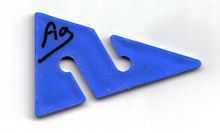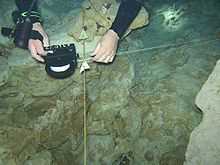Line marker


In cave (and occasionally wreck) diving, line markers are used for orientation as a visual and tactile reference on a permanent guideline. Directional markers (commonly arrows), are also known as line arrows or Dorff arrows, and point the way to an exit. Line arrows may mark the location of a "jump" location in a cave when two are placed adjacent to each other. Two adjacent arrows facing away from each other, mark a point in the cave where the diver is equidistant from two exits.
Non-directional markers ("cookies") are purely personal markers that mark specific spots, or the direction of one's chosen exit at line intersections / T's where there are options. One important reason to be adequately trained before cave diving is that incorrect marking can confuse and fatally endanger not only oneself, but also other divers.
The line arrow was invented by Lewis Holzendorf and developed by Forrest Wilson at the Cave diving NSS workshop, inspired by Sheck Exley and other cave diving pioneers, and later, a few hundreds of the handmade were sold through Branford Dive Center in North Florida. Soon they became very popular and today are commonly used by underwater cave explorers.[1]
See also
External links
References
- ↑ Dive Rite. "Line Arrow". Dive Rite website. Retrieved 20 October 2011.
